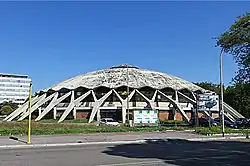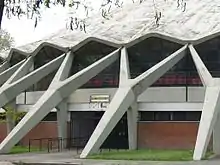PalaTiziano | |
 | |
| Location | Piazza Apollodoro I-00199 Rome |
|---|---|
| Coordinates | 41°55′47″N 12°28′15″E / 41.929617°N 12.470732°E |
| Owner | Municipality of Rome |
| Capacity | Basketball: 3,500[1] |
| Surface | Parquet |
| Construction | |
| Broke ground | 1956 |
| Built | 1957 |
| Opened | 1957 |
| Renovated | 2021–2024[1] |
| Architect | Annibale Vitellozzi |
| Structural engineer | Pier Luigi Nervi |
| Services engineer | Ingg. Nervi & Bartoli |
| Tenants | |
| M. Roma Volley (2006–present) Virtus Roma (1960–1983, 2000–2003, 2011–2018) LUISS Roma (2023–present) | |
The Palazzetto dello Sport (literally "Small Sport Palace"), also less commonly known as the PalaTiziano[2] or PalaFlaminio,[2] is an indoor arena that is located in Piazza Apollodoro, in Rome, Italy. It has a 3,500 seating capacity for basketball games.[2]
History
The venue was constructed along with the 11,500-seat Palazzo dello Sport, for the 1960 Summer Olympics, and it was inaugurated in 1957.[3] It was designed by architect Annibale Vitellozzi[3] its reinforced thin-shell concrete dome was engineered by Pier Luigi Nervi under the direction of Engineer Giacomo Maccagno.[3] During the Olympics, the arena hosted the basketball events, among other sports.[4] Since then it has also been used for volleyball matches and other events.
Home of Virtus Roma
At various times over the years, the arena has been home to the Italian professional basketball team, Virtus Roma. The team played there from its foundation, until the early 1980s, and also for a period of several years at the start of the current millennium, when its regular home venue at the Palazzo dello Sport was being renovated. The team moved back to the arena in 2011, as the Palazzo dello Sport (since renamed PalaLottomatica), had high management costs and Virtus Roma was out of EuroLeague competition at the time.[5] The club moved back to the PalaLottomatica in 2018 as the renovation of PalaTiziano was approaching.
Design

The facility incorporates a first-aid center, four groups of dressing rooms, along with an officials dressing room, a medical sports centre, a management office, a press room with 12 telephone booths, two store rooms, and basement-located heating and air-conditioning equipment.[3] Seating could be configured for 3,500 basketball spectators and up to 5,600 for boxing or wrestling spectators.[3]
The arena is constructed with a ribbed concrete shell dome, that is 61 meters in diameter, and is constructed of 1,620 prefabricated concrete pieces,[3] which are braced by concrete flying buttresses. Much of the structure was prefabricated, so that the dome was erected in 40 days.[6]
See also
- Norfolk Scope, also by Nervi
References
- 1 2 Grilli, Fabio (10 October 2023). "PalaTiziano sempre più ambito: domenica riapre, ma con mille posti in meno". RomaToday (in Italian). Retrieved 3 December 2023.
- 1 2 3 I NUMERI DEL PALATIZIANO Archived 2011-07-22 at the Wayback Machine
- 1 2 3 4 5 6 "The XVII Olympiad Rome 1960, Volume I, The Official Report of the Organizing Committee p59" (PDF). Federal Register May 4, 07 p.25485. Archived from the original (PDF) on 2012-10-27. Retrieved 2010-10-28.;
- ↑ 1960 Summer Olympics official report. Archived 2012-10-27 at the Wayback Machine Volume 1. pp. 60, 62.
- ↑ "Il Palazzetto dello Sport" (in Italian). Pallacanestro Virtus Roma. Archived from the original on 22 October 2013. Retrieved 4 October 2017.
- ↑ Fletcher, Banister; Palmes, J.C. (1975). A History of Architecture. Charles Scribner's Sons. p. 1264. ISBN 0-684-14207-4.
External links
![]() Media related to Palazzetto dello Sport (Rome) at Wikimedia Commons
Media related to Palazzetto dello Sport (Rome) at Wikimedia Commons

